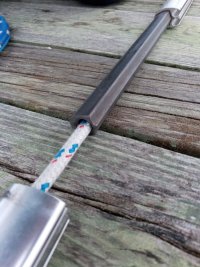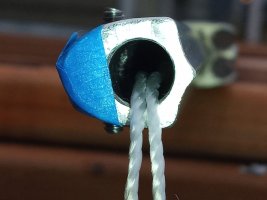While there may be some people on this site I would choose to argue with just for the sport of it, Guy Stevens wouldn't likely be one of them. So, when Guy posted (see #35) that the Harken Mk I is a "twice recalled furler," I asked:
@Guy Stevens
But what's a casual owner to do at this point? It's been working fine for me. Once the head stay has been replaced, it doesn't seem worth preemptively replacing a furler that's still working and will likely continue to do so. No?
My best attempt to answer this question, to date, has been to, "tear this thing apart and see what it's really made of." Here's what I've found so far (I'll just delve into the roll pin issue here and address the lower turnbuckle bolt in a later post). This is all just my $.02:
In regards to the roll pins falling out, leaving the sail "unfurlable:" The loss of a single roll pin, absent one or two other failures,
cannot likely cause this to happen. This is because the aluminum connectors that mate the foil sections are spade-shaped and not round.


Each connector takes two roll pins--one for each of the foil sections it joins together. If a
SINGLE pin falls out, the spade shape ensures that the two adjacent foils still rotate together (while gravity holds one resting firmly atop the other) unless at least
TWO OTHER possible failures occur. Those being;
(A) the loss of the second roll pin on that
SAME connector
AND the failure of the Loctite applied (between the foils and connector) during installation. If
ALL THREE of these occur, then the connector can become loose inside the foil and slide down below the seam between the adjacent foil sections. Then, when the lower portion of the foil rotates during furling, the upper "disconnected" foil half does not rotate, but is free to streamline, along with the sail, wherever the wind pulls it.
Or, (B) an installation error allowing more than 3.5" of clearance at the top of the foil
AND failure of the Loctite on the
SAME section that lost its roll pin (Harken specifies 1.5” clearance above the furler foil). In this case, the interior connector becomes loose from only one of the two foil sections it spans. Gravity still holds the two foil sections together (and the spade shaped connector still causes them to rotate together)
UNTIL a sail is hoisted up the foil's sail track. If more than 3.5" of clearance exists at the top of the foil, the process of hoisting a sail could lift the "loose" upper foil section off of the connector (connectors are 7" long). If this happens, the upper half of the foil becomes "disconnected" from the lower half, leaving it free to rotate (or not) with the same result as in (A).
None of this is meant to doubt that these multiple, linked failures didn't actually happen, as Guy says, and with enough regularity to actually force Harken to recall the foil. On the contrary, my hunch is that these failures were most likely caused specifically
BY the installation process.
First, Loctite was probably a poor choice for this application. Loctite's own tech data sheet (
https://dm.henkel-dam.com/is/conten...-Red-271-Carded-Tube-0.20-fl-oz-2018-04-09pdf) says:
- "The product cures anaerobically, when there is an absence of air between close fitting metal surfaces"
- "Cure Time: 24 hours--dependent on temperature, and type of metal being bonded"
- "A primer is needed if two inactive metals are used"
I don't know that connectors-and-foils pass the "close fitting" test (versus, say, nuts-and-bolts). Here, one part was meant to easily slide inside the other without interference. Second, if many riggers/installers considered a furler installation to be a half-day job, then it makes you wonder if all parts were thoroughly cleaned, primed and fully cured before installation. Finally, if the furler was allowed to bend excessively while being hoisted, that likely caused the single highest stress ever placed on the roll pins.
A roll pin coming loose shortly after initial installation seems possibly a much higher likelihood than that of one falling out 30+ years later (especially considering the corrosive bonding that occurs between stainless (the pins) and aluminum (the foil) over time--though the Loctite may have limited this effect somewhat.
Ultimately, everyone who still uses an old Mark I has to make his/her own decision about its adequacy for continued use. For me, it does seem pretty safe to say that if your roll pins haven't fallen out by now, I wouldn't lose a lot of sleep over them. That said, after having removed several of my roll pins during this disassembly, I have to make a separate decision about the risks of
RE-INSTALLING them. I'm currently exploring the option of tapping the old roll-pin holes to a 6-32 thread and installing 3/4" long #6 set screws in place of the pins.



